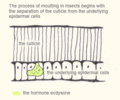Ecdysis
Ecdysis is a biological process by which many arthropods grow. This process, also known as moulting or shedding, involves the animal periodically shedding its exoskeleton (outer protective covering) and forming a new one.
Overview[edit]
Ecdysis is a critical part of the life cycle of arthropods, including insects, crustaceans, and arachnids. The process is controlled by hormones and allows the animal to grow by discarding its old, restrictive exoskeleton. The new exoskeleton is initially soft, allowing the animal to increase in size before it hardens and provides protection again.
Process[edit]
The process of ecdysis begins with the separation of the old exoskeleton from the underlying skin, or epidermis. This is followed by the secretion of a new exoskeleton beneath the old one. Once the new exoskeleton is fully formed, the animal increases its intake of air or water to expand its body and break open the old exoskeleton. The animal then emerges and the new exoskeleton hardens.
Hormonal Control[edit]
The process of ecdysis is controlled by two main hormones: ecdysone and ecdysis-triggering hormone (ETH). Ecdysone is responsible for initiating the process of moulting, while ETH triggers the actual shedding of the old exoskeleton.
See Also[edit]
References[edit]
<references />
|
|
|
Ecdysis[edit]
-
Rhopalomyia solidaginis eclosion
-
Cicada molting animated
-
The arthropods moulting 1
-
The arthropods moulting 2
-
The arthropods moulting 3
-
Crab spider female in ecdysis; Genus Synema, Family Thomisidae
-
Araignée en train de muer
Ad. Transform your life with W8MD's Budget GLP-1 injections from $75


W8MD offers a medical weight loss program to lose weight in Philadelphia. Our physician-supervised medical weight loss provides:
- Weight loss injections in NYC (generic and brand names):
- Zepbound / Mounjaro, Wegovy / Ozempic, Saxenda
- Most insurances accepted or discounted self-pay rates. We will obtain insurance prior authorizations if needed.
- Generic GLP1 weight loss injections from $75 for the starting dose.
- Also offer prescription weight loss medications including Phentermine, Qsymia, Diethylpropion, Contrave etc.
NYC weight loss doctor appointmentsNYC weight loss doctor appointments
Start your NYC weight loss journey today at our NYC medical weight loss and Philadelphia medical weight loss clinics.
- Call 718-946-5500 to lose weight in NYC or for medical weight loss in Philadelphia 215-676-2334.
- Tags:NYC medical weight loss, Philadelphia lose weight Zepbound NYC, Budget GLP1 weight loss injections, Wegovy Philadelphia, Wegovy NYC, Philadelphia medical weight loss, Brookly weight loss and Wegovy NYC
|
WikiMD's Wellness Encyclopedia |
| Let Food Be Thy Medicine Medicine Thy Food - Hippocrates |
Medical Disclaimer: WikiMD is not a substitute for professional medical advice. The information on WikiMD is provided as an information resource only, may be incorrect, outdated or misleading, and is not to be used or relied on for any diagnostic or treatment purposes. Please consult your health care provider before making any healthcare decisions or for guidance about a specific medical condition. WikiMD expressly disclaims responsibility, and shall have no liability, for any damages, loss, injury, or liability whatsoever suffered as a result of your reliance on the information contained in this site. By visiting this site you agree to the foregoing terms and conditions, which may from time to time be changed or supplemented by WikiMD. If you do not agree to the foregoing terms and conditions, you should not enter or use this site. See full disclaimer.
Credits:Most images are courtesy of Wikimedia commons, and templates, categories Wikipedia, licensed under CC BY SA or similar.
Translate this page: - East Asian
中文,
日本,
한국어,
South Asian
हिन्दी,
தமிழ்,
తెలుగు,
Urdu,
ಕನ್ನಡ,
Southeast Asian
Indonesian,
Vietnamese,
Thai,
မြန်မာဘာသာ,
বাংলা
European
español,
Deutsch,
français,
Greek,
português do Brasil,
polski,
română,
русский,
Nederlands,
norsk,
svenska,
suomi,
Italian
Middle Eastern & African
عربى,
Turkish,
Persian,
Hebrew,
Afrikaans,
isiZulu,
Kiswahili,
Other
Bulgarian,
Hungarian,
Czech,
Swedish,
മലയാളം,
मराठी,
ਪੰਜਾਬੀ,
ગુજરાતી,
Portuguese,
Ukrainian









